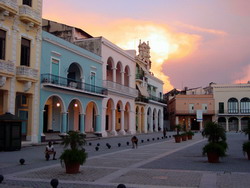Cuba's rich colonial past
- Submitted by: admin
- Travel and Tourism
- Arts and Culture
- Camagüey
- Cienfuegos
- culture an traditions
- Culture and Traditions
- Destinations
- Entertainment
- Havana
- History
- history
- Music
- national
- personalities
- Santiago de Cuba
- Society
- Business and Economy
- Personalities
- 12 / 08 / 2009

The Caribbean island of Cuba is investing heavily in its heritage after years of letting its buildings go to rack and ruin.
There are now plenty of boulevards, handsome old house and theatres to be admired and the charm of Cuba's colonial past is not only to be found in the capital Havana either. There is scope for nostalgia in other cities too, ranging from Cienfuegos and Trinidad across to Santiago de Cuba in the east.
Admittedly, a lot remains to be done and visitors will find the contrast between old and new particularly crass in Havana.
Between the golden dome of the Capitol and the cathedral numerous groups of workmen toil away, yet just a few streets farther on, staircases, roofs and even whole house are propped up with timber scaffolding lest they collapse completely.
Those who stray from the well-trodden tourist paths in Havana will still come across much neglected architecture and scruffiness and will no doubt frequently ask themselves: "Doesn't anybody collect the refuse around these parts?"
Trinidad on the south coast is a perfect relic of the early days of the Spanish colony, a virtual open air museum with a wealth of preserved streets and buildings.
Tourists from all over the world dine on octopus or chicken with rice and beans to the sound of groups like Trinitarios.
Naturally the musicians play evergreens like Guantanamera and numerous songs in honour of the late revolutionary leader Che Guevara.
Streets of renovated one-storey houses fan out from the Santisima Trinidad cathedral, all of them festooned with pictures of Che and political slogans with facades decorated with wrought-iron and flowery bowers.
Trinidad was founded in 1513 by seafarer Diego Velazquez de Cuellar and flourished until the first half of the 19th century during an era when the sugar barons ruled the roost. The Valley of the Sugar Mills just outside the town offers lush vegetation and a glimpse of former plantation glory and like the old quarter of Trinidad, the location is a UNESCO world heritage site.
Trinidad is popular but seldom overcrowded and visitors soon find themselves strolling alone among the picturesque squares, courtyards and cobbled streets with their tranquil fountains. One such refuge is the "Casa de la Cultura" where Susana Garcia displays her paintings. In the House of Literature close by visitors can relax while browsing the bookshelves or watching a game of chess.
The historical centre of the seaport and industrial city of Cienfuegos enjoys protection from modern development too. "That really gave tourism here a boost," said Maria de los Angeles Guillen who runs a local three-star hotel. A double room for the night costs 60 euros (90 dollars).
Her meagre foreign currency reserves do not run to providing expensive imported hams and cheeses for breakfast but she and her staff more than make up for this by their friendliness and a wide range of delicious local produce.
In the evenings both locals and tourists who want to eat out are spoilt for choice. There are dozens of restaurants and cafes along the main boulevard and in the neo-classical theatre around the Parque Jose Marti a performance of Carmina Burana is about to begin. Next door a comedy troupe and a jazz band are raking in the applause. Entry to these amusements is free of charge.
Over at the eastern end of the island in Cuba's second city Santiago, a sweet melody drifts through the night from the "Casa de la Trova" in the Calle Heredia. The singer is recounting the woes of an impoverished lover.
Santiago de Cuba has more of an ethic blend than almost any other city on the island and is famed for its musical heritage, having spawned styles such as Son which became known worldwide through the film Buena Vista Social Club.
Many visitors come to the so-called "heroic city" of Santiago in search of traces of the revolution. Cuban icon Fidel Castro attempted to depose dictator Batista on July 26, 1953 by storming the Moncada garrison but his forces were repulsed by troops
loyal to the government.
Castro survived to take his place on the town hall of the balcony six years later from where he proclaimed the triumphant revolution. The Cuartel de Mocada is now one of the many museums in the former island capital.
Elsewhere, towns such as Holguin not far from the beaches of the northern coastline, Guardalavaca or sleepy Baracoa in the far east offer colonial boulevards, parks and authentic Cuban atmosphere galore.
Havana remains nevertheless the essential stop on any tourist itinerary since it contains the most extensive relics of Spanish colonial presence with countless baroque and neo-classical buildings. Restoration in the Habna Vieja is advancing
rapidly, thanks in the main to one expert, Eusebio Leal.
The communist official with entrepreneurial skills has known for two decades now that lovingly created historical buildings and squares act as a magnet for tourists and bring much needed foreign currency into the country which in turn enables more
preservation work to be carried out.
At present the Plaze Vieja,one of the oldest market squares in Havana, is being restored to its former glory. Most of the buildings are already completed and in the nearby "Taberna de la Muralla" beer is brewed on the premises. For those who like
their refreshment even cooler, the "Escoria" ice-cream parlour opposite has delicious ice cream with brittle pecan chunks, a
slice of cheese cake and a Cappuchino coffee.
Copyright DPA
Source: www.earthtimes.org
Comments